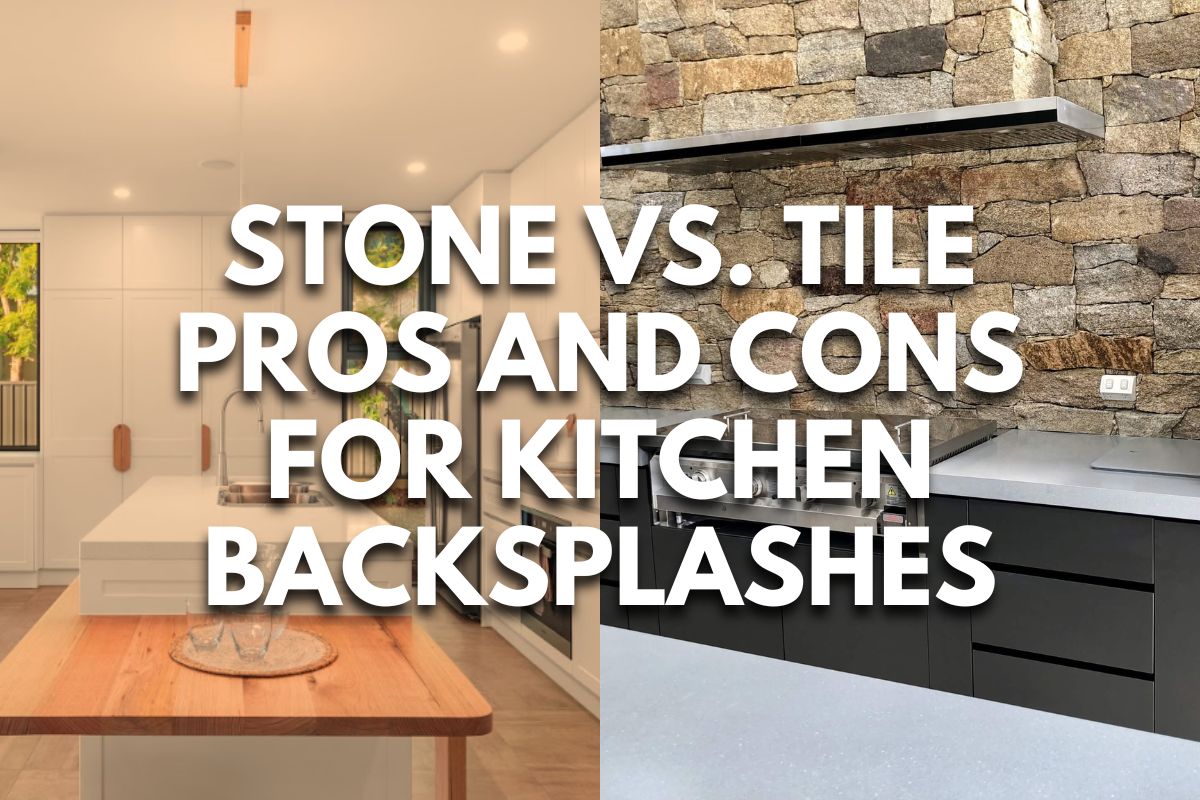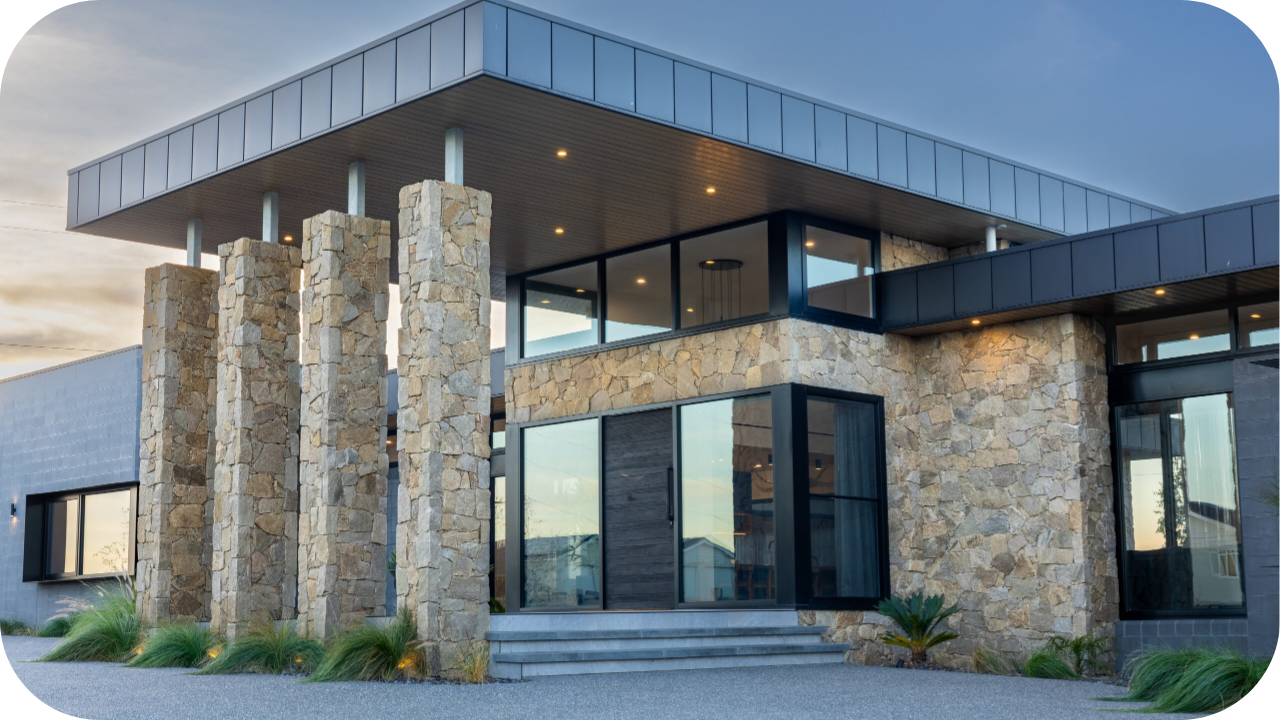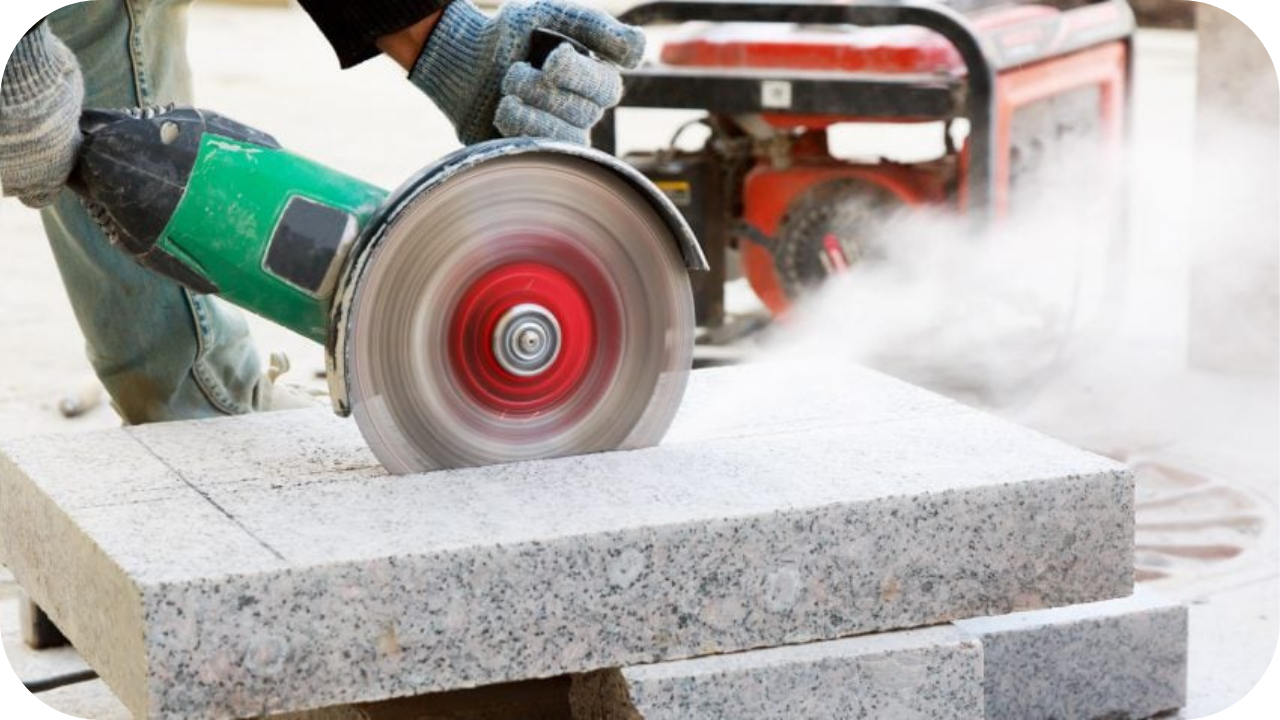
Deciding on the perfect kitchen backsplash is daunting. Should you go with the timeless elegance of stone or the versatile charm of tile?
Each material comes with its unique blend of benefits and drawbacks.
Stone offers unmatched elegance but at a high cost and maintenance demand, whereas tile provides versatility and ease of upkeep but may lack a distinct luxurious appeal.
Dive into our detailed guide as we compare stone and tile backsplashes, highlighting pros and cons to help you seamlessly blend style with function in your kitchen’s centrepiece.
Stone Backsplashes
When considering stone backsplashes for your kitchen, it’s important to weigh the advantages and challenges of this choice.
Here’s a detailed breakdown of the pros and cons:
| Pros | Cons |
| Durability: Stone backsplashes, like those made from granite or marble, are highly durable and resistant to the everyday wear of a busy kitchen. They effectively withstand heat, moisture, and scratches, making them ideal for areas behind the stove or sink. | Cost: Stone is generally more expensive than other materials. The price includes raw materials and the specialized labor required for precise cutting and installation. |
| Cost: Stone is generally more expensive than other materials. The price includes raw materials and the specialised labour required for precise cutting and installation. | Maintenance Requirements: Stone surfaces require regular maintenance to retain their appearance and durability. This includes periodic sealing to prevent stains and damage from acidic substances. |
| Limited Design Options: While stone offers a distinct look, it may not always align with all design themes. Natural patterns can restrict your colour palette and style choices, making it a less versatile option than tiles. | Natural Beauty: Stone’s aesthetic appeal is unmatched. Each slab features unique colours and veining, adding a touch of natural elegance that synthetic materials cannot replicate. This can significantly enhance the overall look of your kitchen. |
Tile Backsplashes
When considering tile backsplashes for your kitchen, it’s crucial to understand their benefits and drawbacks.
Here’s a detailed breakdown of the pros and cons:
Tile Backsplashes
| Pros | Cons |
| Affordability: Tiles are more budget-friendly than stone, making them a cost-effective option for kitchen backsplashes. | Susceptibility to Cracks: Tiles are prone to cracking under heavy impact or, if not correctly installed, may pose a durability issue. |
| Versatility: Tiles come in various materials, including ceramic, porcelain, glass, and metal, accommodating any design aesthetic. | Grout Maintenance: Grout lines between tiles can attract stains and dirt, requiring regular cleaning and occasional resealing to prevent moisture issues and mold growth. |
| Grout Maintenance: Grout lines between tiles can attract stains and dirt, requiring regular cleaning and occasional resealing to prevent moisture issues and mould growth. | Less Natural Appearance: Compared to stone, tiles can have a more manufactured look, which might be less appealing if you aim for a natural kitchen aesthetic. |
Comparison of Durability and Maintenance
In the context of kitchen backsplashes, both stone and tile offer distinct durability characteristics and maintenance requirements.
Understanding these can help homeowners choose the best material for their kitchen’s demands. Here is a direct comparison of durability and maintenance for stone and tile backsplashes:
Comparison of Durability and Maintenance
| Aspect | Stone Backsplashes | Tile Backsplashes |
| Durability | Stone backsplashes, including materials like granite and marble, are highly durable. They resist heat, moisture, and scratches exceptionally well, making them suitable for the rigorous demands of kitchen environments. | Tile backsplashes are also durable but are generally more susceptible to cracks and chips, especially in high-impact areas. Materials like ceramic and porcelain can withstand daily kitchen use but require careful handling to avoid damage. |
| Cleaning | Regular cleaning is straightforward, requiring only a damp cloth and mild detergent. However, the porous nature of some stones, like marble, can absorb stains if not wiped up promptly. | Tile cleaning is generally easy with similar methods. However, tiles with textured surfaces may require additional effort to remove grime and buildup in crevices. |
| Sealing | Most stone types require periodic sealing to prevent water absorption and staining. This maintenance task is crucial for preserving the backsplash’s aesthetic and functional integrity. | Sealing is not typically required for glazed tiles but is necessary for unglazed tiles and the grout lines to protect against moisture and stains. |
| Repairs | Repairs on stone can be more complex and costly, especially if a match needs to be found for a particular vein or color pattern. | Tile repairs are generally more straightforward and more cost-effective. Individual tiles can be replaced if they crack or chip, making it a more manageable long-term maintenance option. |
Aesthetic Considerations
Stone Backsplashes
Stone backsplashes are highly valued for their natural beauty and luxurious appearance.
Each slab of stone, such as granite or marble, boasts unique variations in colour and pattern, making each installation one-of-a-kind. This natural artistry can add a sense of grandeur and sophistication to any kitchen.
The intrinsic characteristics of stone provide a rich, organic feel that can anchor the space’s overall design, lending an air of timeless elegance that is difficult to replicate with other materials.
Tile Backsplashes
Tile backsplashes are versatile and available in various colours, patterns, and textures. This variety allows homeowners to customise their kitchen’s appearance extensively.
Whether you’re looking for the glossy finish of ceramic tiles, the rustic charm of terra cotta, or the modern sheen of glass tiles, the possibilities are nearly limitless.
This adaptability makes tile an excellent choice for those looking to match their backsplash with specific colour schemes or design motifs, or create a focal point that stands out in the kitchen decor.
Cost Analysis
Material and Installation Costs
Stone backsplashes, such as granite or marble, typically carry higher material costs compared to tiles.
The cost of stone can vary widely based on the material’s type, quality, and origin. Additionally, stone requires specialised cutting and installation, which can further increase labour costs.
On the other hand, tile offers a more budget-friendly alternative with a wide range of prices, depending on the material (ceramic, porcelain, glass, etc.). Tile installation is generally less labour-intensive than stone, making it more cost-effective in terms of both materials and labour.
Long-Term Cost Considerations
In terms of maintenance, stone backsplashes need regular sealing to prevent stains and damage, which can add to the overall cost of upkeep. This maintenance is crucial to preserving the material’s aesthetic and durability, potentially leading to higher long-term costs.
While more effortless and less expensive to maintain, tile may involve replacing cracked or chipped tiles.
However, the ease of replacing individual tiles can mitigate potential repair costs, making it a more manageable long-term expense.
Installation Process
Here’s the installation process for both stone and tile backsplashes summarised in a table format:
Installation Process Comparison
| Backsplash Type | Installation Steps |
| Stone Backsplashes | Measurement and Cutting: The stone must be precisely measured and cut using specialized equipment to fit the kitchen wall dimensions accurately.Installation: The cut stone slabs are carefully mounted using solid adhesives. Due to the weight and delicacy of materials like granite or marble, professional handling is essential to ensure stability and a seamless fit. |
| Tile Backsplashes | Measurement and Cutting: Tiles are measured and cut to accommodate corners and outlets. This can often be done with more straightforward cutting tools. Laying and Adhesive Application: The tiles are arranged to check for fit and design before being affixed to the wall with adhesive. Grouting and Sealing: After the adhesive sets, grout is applied between the tiles to fill gaps, and then the grout is sealed to prevent moisture ingress and facilitate cleaning. |
Environmental Impact
| Material | Environmental Impact |
| Stone Backsplashes | Stone materials like granite and marble are quarried, impacting local ecosystems and biodiversity due to significant soil and rock removal. Transporting these heavy materials also requires substantial energy, adding to their carbon footprint. However, a stone’s long lifespan mitigates some initial environmental costs. |
| Tile Backsplashes | Tiles are made from natural resources like clay, porcelain, or ceramics. They require energy-intensive kiln firing at high temperatures, which can emit pollutants. The tile industry has progressed by using recycled materials and improving kiln energy efficiency, reducing overall environmental impact. |
Practical Considerations for Kitchen Use
When choosing materials for kitchen backsplashes, practical considerations such as heat resistance, stain resistance, ease of cleaning, and maintenance are paramount. Here’s a focused comparison of these aspects for stone and tile backsplashes:
Practical Considerations for Kitchen Use
- Heat Resistance: Stone backsplashes, especially those made from granite and marble, offer excellent heat resistance, making them ideal for use behind stoves where hot pots and pans occasionally come in contact with the backsplash. In contrast, ceramic and porcelain tiles also provide good heat resistance, although certain types of decorative tiles may be less tolerant to high temperatures.
- Stain Resistance: Stone is naturally porous and can absorb spills if improperly sealed, potentially leading to stains. Sealing stone backsplashes is, therefore, essential for maintaining their appearance. On the other hand, glazed ceramic or porcelain tiles are highly resistant to stains as their surface prevents liquids from penetrating. Grout lines, however, can become discoloured if not sealed or cleaned regularly.
- Ease of Cleaning and Maintenance: Tile backsplashes are generally easier to maintain daily. Simple wiping with a damp cloth and mild cleaner typically keeps tiles looking new. To avoid staining and water damage, stone backsplashes require more careful maintenance, including regular sealing. While both materials are durable, the ease of replacing a single tile also makes tile backsplashes more convenient for addressing damage than stone, which may require more significant section replacements.
Personal Preference and Lifestyle Factors
Choosing the right material for your kitchen backsplash involves careful consideration of personal preferences and lifestyle factors, as these can significantly influence the space’s practicality and enjoyment.
Here’s an analysis of how these elements impact the decision between stone and tile backsplashes:
Importance of Personal Preferences
Choosing stone and tile often starts with personal aesthetic preferences and the kitchen’s overall design style.
Stone offers a unique, luxurious look with natural variations, making it a favoured option for those seeking elegance and a standout design feature.
Conversely, tile offers extensive design versatility. It is available in various colours, patterns, and textures that can complement any design style, from modern to traditional.
Lifestyle and Usage Considerations
The decision should also consider cooking habits and kitchen activity.
Materials that offer durability and easy maintenance, like tile, might be more suitable for frequent cooking and potential exposure to heat and spills.
Additionally, households with children or pets prefer tile due to its resilience and ease of cleaning.
Household Composition
The composition of the household plays a crucial role. Families with young children or busy kitchens might lean towards tile for its durability and low maintenance.
In contrast, those who entertain often or desire a more sophisticated ambience might opt for stone’s unique beauty.
Conclusion
Consider durability, maintenance, and design preferences when choosing between stone and tile backsplashes. While stone offers natural beauty and durability, tile provides versatility and affordability.
Your kitchen’s aesthetic and practical needs should guide your decision.
Consider the factors and choose a stunning and functional kitchen space wisely.
More To Explore

Can Buffalo Granite Withstand Extreme Weather Conditions?
Australia’s climate demands more from building materials. From scorching summers to coastal salt exposure and frost-prone winters, walls need strength that lasts. Buffalo Granite is

Safety Considerations When Cutting or Drilling Beachport Quartz
Working with Beachport Quartz isn’t just about precision cuts. It also involves serious health and safety concerns that cannot be ignored. This quartz-rich stone contains


